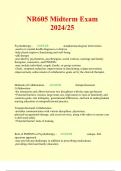NR605 Midterm Exam
2024/25
Psychotherapy - ANSWER -nonpharmacological intervention
-used to tx mental health diagnoses or distress
-help clients improve functioning and well-being
-talk therapy
-provided by psychiatrists, psychologists, social workers, marriage and family therapists, counselors, and PMHNPs
-may include individual, couple, family, or group sessions
-Goals: symptom reduction, improvement in functioning, relapse prevention, empowerment, achievement of collaborative goals set by the client & therapist.
Methods of Collaboration - ANSWER Intraprofessional Collaboration
-the interaction and efforts between two disciplines with the same profession
• Potential barriers: tension, large team size, high turnover, lack of familiarity and common goals, role ambiguity, generational differences, and lack of undergraduate
nursing education on intraprofessional practice.
Transprofessional Collaboration
-includes communication with various disciplines: physicians, physical/occupational therapy, and social services, along with others to ensure care
is delivered safely
• Potential barrier: lack of training
Role of PMHNPs in Psychotherapy - ANSWER -unique, full-
spectrum approach
-may provide psychotherapy in addition to prescribing medications
-providing client and family education -coordinating care and referrals as a part of the treatment plan
-provide psychotherapy in a variety of ambulatory, emergency department, inpatient, and outpatient settings
Holistic Paradigm of Healing - ANSWER -holistic model of care with a focus on healing
-Holistic therapy respects the complexity of each unique individual
• appreciating the relationship between the client's mind, body, and spirit
• recognizing the interdependence of all parts of the human system
-Foundational to healing is the relationship between the client and therapist
• Emotional connection in the relationship is critical to the success of psychotherapy
• PMHNP approaches the nurse-client relationship with acceptance, empathy, patience, and kindness to create a space for healing
-psychotherapy can help the individual accept dysregulation and disharmony in the
present moment
• achieves acceptance of the present, they may be able to let go of resistance, relax,
and release fears
Theoretical Models in Psychotherapy - ANSWER Maslow's Hierarchy of Needs
Health Belief Model
Transtheoretical Model of Change
Maslow's Hierarchy of Needs - ANSWER framework for understanding client motivation
-first four levels of need in the hierarchy (physiological needs, safety, love and belonging, and esteem) are sometimes referred to as deficiency needs (D-needs)
• Motivation decreases once D-needs are met
-highest level of need, self-actualization, is considered a growth or being need (B-
need)
• Once D-needs are met, clients can focus on self-actualization and personal growth
• As the B-need is met, motivation for further growth increases self-actualized person - ANSWER is self-fulfilled
-Qualities exhibited by the self-actualized person include independence, autonomy,
creativity, and maturity
Maslow's Hierarchy of Needs Pyramid - ANSWER TOP: Self-
actualization
-Morality, creativity, spontaneity, lack of prejudice, acceptance of facts
Esteem
-Self-esteem, respect, achievement, confidence
Love/Belonging
-Friendship, family, intimacy, sense of connection with others
Safety
-Security of body, of employment, of resources, of morality, of the family, and of health, of property
Bottom: Physiological
-Air, food, water, shelter, clothing, sleep
Health Belief Model - ANSWER -used to explain and predict health behaviors
-a person's belief about a perceived threat of illness combined with belief in the effectiveness of the recommended action predict the person's willingness to change
-constructs: • perceived seriousness
• perceived susceptibility
• perceived benefits of treatment
• perceived barriers to treatment
• cues to action
• self-efficacy Transtheoretical Model of Change - ANSWER assumes that behavior changes take place over time and that people move through stages of decision-making to make changes to behavior
-stages: • precontemplation
• contemplation
• preparation
• action
• maintenance
Nancy is a 64-year-old who is wondering if losing weight might benefit her self-
esteem and self-confidence. Based on the transtheoretical model of change, which of the following actions by the PMHNP would be appropriate for Nancy if she is in
the contemplation stage of change?
Ask Nancy to create a list of reasons that she wants to lose weight.
Refer Nancy to her primary provider to obtain medical clearance for an exercise program.
Explore Nancy's anxiety and emotional responses related to be - ANSWER Ask Nancy to create a list of reasons that she wants to lose weight.
Rationale: Creating a list of reasons to lose weight would be appropriate for the contemplation phase. Obtaining medical clearance for exercise is a part of the preparation phase of the Transtheoretical Model of Change. Exploring emotional responses to being overweight would be appropriate for the precontemplation phase. Addressing rewards for reinforcement of behaviors would occur in the action phase.
Treatment Hierarchy Framework - ANSWER therapeutic aims at the
base of the model must be addressed before the client can move up the triangle
Top: Stabilization




